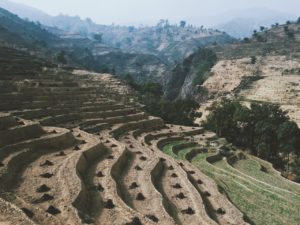Introduction
Pesticide use in Nepal started in the early 1950s with DDT for malaria eradication. Various fungicides such as Dithane M-45 (mancozeb), Dithane Z-78 (zineb), Fytolan or Blitox-50 (copper oxychloride) and Bavistin were evaluated as foliar sprays for the control of various foliar and cob rot diseases.
However, spraying fungicides for the control of maize diseases is not advisable in Nepal. As a result, seed treatment with Sumi 8 (diniconazole), Tilt (propiconazole), Raxil (tebuconazole) or Bayleton (triademefon) at the rate of 2 g or ml/ kg seed has been found most effective for the control of the diseases. Chemicals such as Hinosan, CGA 49104, Kasugamycin, Beam were found to be effective for the control of rice blast.
Use of Chlordane, DDT, Dieldrin, Endrin, Aldrin, Heptachlor, Toxafen, Mirex, BHC, Lindane, Phosphamidon, Orano mercury fungicides, Methyl parathion and Monocrotophos are banned in Nepal.
A total of 178 tons of pesticides were used in 2003, of which insecticides (58%) and fungicides (31%) were consumed. Terai (25.04% of land holdings) has maximum pesticide usage than Mid-hills (8.38%) and Mountains (7.14%). However, the amount of pesticides used in Nepal is considered insignificant (142 gm/ha) in comparison to India (500 gm/ha), Korea (6.6 kg/ha), Japan (12 kg/ha).
Government of Nepal (GoN) is the signatory of Stockholm Convention, Basel Convention and Rotterdam Convention to manage agrochemicals.
Materials and methods
Study area
Rupandehi district of Western Development Region (WDR) in Nepal.
Methodology
Stratified random sampling (171 individuals from 21 VDCs and 1 municipality). Data sampling was performed by ArcGIS, SPSS and MS Excel.
Questions
a. If fertilizers and pesticides were used previously?
b. How often they were used?
c. Which pesticides were mostly applied and why?
d. The knowledge of pesticide toxicity and symptoms?
e. Attitude towards the cost of the pesticides ?
f. Types of agrochemicals application method?
g. The fate of left over agrochemicals and storage?
h. The disposal of empty pesticide container?
i. The pesticide impact on environment?
j. How one can reduce the agrochemicals impact on human and environment?
Results and discussion
Negative effects of agrochemicals residues
Decline in quality of organic matter, ammonification and nitrification, mineralization/ decomposition by fungi are resulted due to application of agrochemicals in soil.
Bio magnification results to fish kills, reproductive failures in birds. Asthma, cancer, reduced sperm quality and count, affected endocrine and immune systems occurs in human.
Farmer’s awareness of agrochemical residues
Although 90 (52.63%) respondents were found literate, most respondents lack knowledge of threats of excessive pesticide residues. 170 (99.41%) individuals understand the basic method of agrochemicals application, 168 (98.24%) lacked the concept of bioaccumulation and bio magnification.
| Variables | N | Percentage |
| Cost of pesticides | ||
| Extremely expensive | 150 | 87.71 |
| Expensive | 21 | 12.28 |
| Non expensive | 0 | 0 |
| Type of agrochemicals used | ||
| Urea | 4 | 2.33 |
| Animal dung | 17 | 9.94 |
| Animal dung + Urea + DAP + Potash | 57 | 33.33 |
| Urea + DAP + Potash | 73 | 42.69 |
| Compost | 20 | 11.69 |
| Adverse effects of agrochemicals* | ||
| Environmental pollution | 171 | 100 |
| Killing of non-target species | 10 | 5.84 |
| Insecticide resistance | 5 | 2.92 |
| Agrochemicals storage practice | ||
| Hanging inside | 10 | 5.84 |
| On top of the house | 21 | 12.28 |
| Locked up in a safe place | 123 | 71.92 |
| Along with food stuffs | 17 | 9.94 |
| Leftover agrochemicals solution | ||
| Stored and used for another application | 95 | 55.55 |
| Pour into bushes /river/ stream | 12 | 7.01 |
| Sell it to other farmers | 4 | 2.33 |
| Apply even though it is not needed | 60 | 35.08 |
| Disposed on the soil | 0 | 0 |
| Disposal of empty agrochemicals containers | ||
| Use them for household purpose | 11 | 6.43 |
| Buried | 25 | 14.61 |
| Left in the farm/ nearby farm itself | 50 | 29.23 |
| Burnt | 45 | 26.31 |
| NA | 40 | 23.39 |
| Whether you have received any training regarding the use of agrochemicals? | ||
| Yes | 4 | 2.33 |
| No | 167 | 97.66 |
| Personal protective devices (PPDs) | ||
| Yes | 21 | 12.28 |
| No | 150 | 87.71 |
| Health impacts* | ||
| Headache | 161 | 94.15 |
| Fever | 60 | 35.08 |
| Dizziness | 50 | 29.23 |
| Abdominal pain | 29 | 16.95 |
| Allergy | 30 | 17.54 |
| Dermatitis and conjunctivitis | 80 | 46.78 |
Table 1. Perception of farmers towards agrochemicals and their sustainable uses
Conclusion and Recommendation
Use of bio pesticides, bioremediation of pesticide contaminated land, transgenic crop cultivation is some of the alternatives. Mechanisms for enforcing regulations adopting FAO guidelines should be developed with adequate educational and training interventions. Enhanced surveillance, management of pesticide poisoning, raising awareness at grass root level are necessary.
Reference to original paper
Bhandari, G. (2014). An Overview of Agrochemicals and Their Effects on Environment in Nepal. Applied Ecology and Environmental Sciences, 2(2), 66-73. doi: 10.12691/aees-2-2-5








